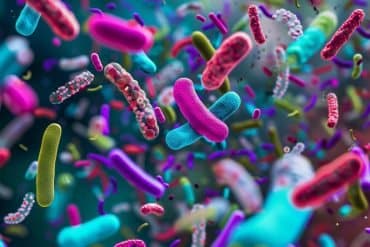Clinical trials are testing whether oxytocin, sometimes called the “love hormone” for its role in intimacy and social bonding, has potential as a treatment for anxiety, depression and post-traumatic stress disorder. New research by behavioral neuroscientists Michael Steinman, Brian Trainor and colleagues at the University of California, Davis, suggests oxytocin may have different effects in men and women–and in certain circumstances the hormone may actually trigger anxiety.
In a series of experiments at the UC Davis Department of Psychology, the team administered doses of oxytocin with a nasal spray to male and female mice. Some of the mice were bullied by an aggressive mouse, an experience that reduces motivation to associate with unfamiliar mice. Consistent with previous studies, oxytocin increased the motivation for social interaction in stressed males.
However, in stressed females, oxytocin had no effect. When non-stressed females received oxytocin, social motivation was reduced. This effect of oxytocin is similar to the effect of social stress.

“Reduced social motivation can be part of a depression-like syndrome,” said Trainor, an associate professor of psychology.
Trainor and colleagues found important differences in how stress affected the production of oxytocin. After stress, nerve cells in the brain produced more oxytocin in females but not in males. Steinman used a molecular marker to show that these oxytocin-producing cells were also more active in females that experienced stress. Steinman suggests, “This may help explain why oxytocin nasal spray makes females avoid social contact even though they did not experience social stress.”
Clinical studies have found that women with depression or PTSD have elevated oxytocin levels. Usually this result has been thought to reflect an increased drive for social support. The results of Trainor and colleagues suggest an alternate possibility.
“Our results show that stressed females have both reduced social motivation and increased oxytocin. It’s possible that oxytocin might contribute to a depression-like syndrome in females,” Trainor said. “If correct, inhibiting oxytocin action might have unanticipated benefits.”
The surrounding environment also influenced the effects of oxytocin. If mice were tested in a familiar home cage instead of a new environment, oxytocin reduced stress-related behaviors in males and females. This finding shows that the effects of oxytocin depend whether the environment is familiar or unfamiliar.
Trainor said his lab’s findings have implications for studies investigating the utility of oxytocin as a therapeutic. “Most clinical studies investigating oxytocin as a treatment for depression or anxiety include only males,” he said. “It’s important to include both men and women in these studies. The effect of oxytocin may be different if administered by an unfamiliar person or by a person with whom the patient has a personal relationship.”
In addition to Trainor and Steinman, a UC Davis Ph.D. alumnus who is now a post-doctoral researcher at New York University, co-authors were graduate student Natalia Duque-Wilckens; Gian Greenberg, a Ph.D. alum and a post-doctoral researcher at the Oregon Health and Sciences University; staff researcher Rebecca Hao; Katherine Campi, a Ph.D. alum who is now an assistant professor at Sierra College; Sarah Laredo, a Ph.D. alum who is now a post-doctoral researcher at Scripps Research Institute; graduate student Abigail Laman-Maharg; former undergraduates Claire Manning, Ian Doig, Kennan Walch and Eduardo Lopez, who all graduated in 2013; and psychology professor Karen Bales.
Funding: he UC Davis research project was supported by the National Institutes of Mental Health.
Source: Kathleen Holder – UC Davis
Image Credit: The image is credited to Mark Chappell/UC Riverside
Original Research: Abstract for “Sex-Specific Effects of Stress on Oxytocin Neurons Correspond With Responses to Intranasal Oxytocin” by Michael Q. Steinman, Natalia Duque-Wilckens, Gian D. Greenberg, Rebecca Hao, Katharine L. Campi, Sarah A. Laredo, Abigail Laman-Maharg, Claire E. Manning, Ian E. Doig, Eduardo M. Lopez, Keenan Walch, Karen L. Bales, and Brian C. Trainor in Biological Psychiatry. Published online October 16 2015 doi:10.1016/j.biopsych.2015.10.007
Abstract
Sex-Specific Effects of Stress on Oxytocin Neurons Correspond With Responses to Intranasal Oxytocin
Background
Oxytocin (OT) is considered to be a stress-buffering hormone, dampening the physiologic effects of stress. However, OT can also be anxiogenic. We examined acute and long-lasting effects of social defeat on OT neurons in male and female California mice.
Methods
We used immunohistochemistry for OT and c-fos cells to examine OT neuron activity immediately after defeat (n = 6–9) and 2 weeks (n = 6–9) and 10 weeks (n = 4–5) later. We quantified Oxt messenger RNA with quantitative polymerase chain reaction (n = 5–9). Intranasal OT was administered to naïve and stressed mice tested in social interaction and resident-intruder tests (n = 8–14).
Results
Acute exposure to a third episode of defeat increased OT/c-fos colocalizations in the paraventricular nucleus of both sexes. In the medioventral bed nucleus of the stria terminalis, defeat increased Oxt messenger RNA, total OT neurons, and OT/c-fos colocalizations in female mice but not male mice. Intranasal OT failed to reverse stress-induced social withdrawal in female mice and reduced social interaction behavior in female mice naïve to defeat. In contrast, intranasal OT increased social interaction in stressed male mice and reduced freezing in the resident-intruder test.
Conclusions
Social defeat induces long-lasting increases in OT production and OT/c-fos cells in the medioventral bed nucleus of the stria terminalis of female mice but not male mice. Intranasal OT largely reversed the effects of stress on behavior in male mice, but effects were mixed in female mice. These results suggest that changes in OT-sensitive networks contribute to sex differences in behavioral responses to stress.
“Sex-Specific Effects of Stress on Oxytocin Neurons Correspond With Responses to Intranasal Oxytocin” by Michael Q. Steinman, Natalia Duque-Wilckens, Gian D. Greenberg, Rebecca Hao, Katharine L. Campi, Sarah A. Laredo, Abigail Laman-Maharg, Claire E. Manning, Ian E. Doig, Eduardo M. Lopez, Keenan Walch, Karen L. Bales, and Brian C. Trainor in Biological Psychiatry. Published online October 16 2015 doi:10.1016/j.biopsych.2015.10.007






